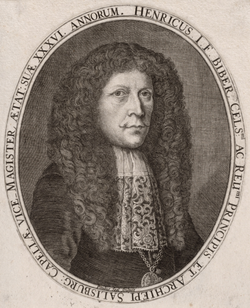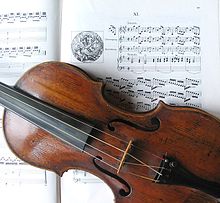The theme of this week’s Smart and Soulful blog is…Music about poultry! Every piece this week contains some illustration or reference to great birds that have been used for human food consumption. While the works in this playlist span centuries I think you will be struck by how similar the representations tend to be across styles. We’ve always been fascinated by birds and their unique mannerisms have provided musicians with inspiration and material to work into their compositions throughout human history. Some have done it almost obsessively, but for many musicians it was just the right thing to try at a certain time.
Music about Poultry, Day 1 – Sonata Representativa by Heinrich Ignaz Franz Biber

This is one of my favorite scenes from the Simpsons:
I think it sums up the difference between learning history out of a textbook and really understanding it in a mature way. But, textbook learning, in spite of its inevitable dearth of nuance and real-world understanding, is so often an important way for students to start learning. So, as much as I despise dividing music history into the neat and tidy style periods typically taught in music history classes, it is often useful to establish these points of reference, even if much is lost in drawing lines that cleanly. The world is a nuanced and fluid place, after all, and anyone who has lived a few decades regards history as a completely different subject than a school student who is memorizing names, dates and places for the next exam. The basic style periods (Medieval, Renaissance, Baroque, Classical, Romantic, Modern) go a certain distance in helping students to get their heads around it all, but you lose so much nuance in doing so, and it is easy for certain figures to be eclipsed simply because they don’t fit comfortably into one of the cut-and-dried divisions. The older I get the more I enjoy looking into those spaces that don’t comfortably fit and understanding what they were all about.
Heinrich Ignaz Franz Biber is a great example. Living from 1644 to 1704, I guess you would technically call him a “Baroque” composer, but it hardly does him justice. While the Baroque era lasted from 1700 – 1750 (so nice and round, right?!) most of the music that we have come to associate with that period’s typical style actually comes from the last 50 years or so, maybe even less. This period of time, from approximately 1700 – 1750, is often referred to as the “high baroque” to distinguish it from the music of up to a century beforehand, which had not quite developed into the clean forms and pristine tonal harmony that characterized the high baroque. But do you suppose anyone ever regards himself as a “transitional figure” during his lifetime? It’s kind of absurd. Stuff happens in the moment, and everyone is more or less trying to make their way through life, no matter how “developed” historians consider their work to be. So I’m content to call Biber a Bohemian violin virtuoso of the late seventeenth century who successfully navigated the various and often intermingled structures of civil and ecclesiastical power, contributing in equal measure to virtuoso instrumental and sacred vocal music, both of which he could create with ease. I’ve read that you could consider Biber’s style to be the finest example of a brand of violin virtuosity and composition that was overshadowed by that of Corelli, which arose about half a generation later, and would prove to be more historically “significant” and impactful to later musicians, but let’s let that go for now. Listen to this, and try to imagine that you have never heard of Bach, Mozart, Beethoven, Brahms, that you are living in Austria of 1669, and hearing this with fresh ears:
It must have been really dazzling to see Biber play that in person. Can you tell how virtuosic and eccentric he must have been to create and perform something like that? What was that anyway? What was with those weird, not-always-terribly-musical-sounds throughout? Glad you asked! It is the Sonata Representativa, which I would translate roughly as “Sonata in which a handful of animals are imitated”. This fun, showy 10 minute piece is actually made of 9 teeny tiny little movements. Some, like the first and last movements, are what you might label as “conventional seventeenth century virtuoso concert music”, if such a thing exists. The sonata opens with an fantasia-overture and ends with a dance. Everything in between those conventional outer movements you might label as “eccentric and highly imaginative sonic experiments regarding the violin’s ability to imitate various small animals to the pleasure of a patron Count who enjoyed such things”. All the middle movements are written in imitation of some kind of small animal and I think they are variously successful, but always entertaining, if only for the odd sounds you get to hear. Watch this video and follow the score. You can also see in the description what each movement seeks to imitate:
You may have caught the cat before following along like that, but I bet that was the only one. That’s the nature of programmatic music – even when music is imitating or representing something concrete the listener usually has to be told, and then it all makes sense. But it really all makes sense now, right? I think Biber captured some of them better than others. I’m particularly impressed by the cat, which really meows and pads along like a cat, and the cock and hen. We have chickens on our property right now and I would say that Biber really got their motions and mannerisms. The intervals kind of magically evoke their range of motion as they look forward and then to the ground, forward and then to the ground, and those pattering repeated notes make it seem like they’re rooting and pecking about. There’s even that presto episode in which they seem to be spooked and running madly. I think that’s a great little movement! The quail I’m not sure about, not having much experience with them. How about you? Do you know what quail are like? Here’s a video:
What do you think?
Heinrich Biber made his interesting and inventive mark on the history of violin virtuosity, although it’s not known as well as Corelli, who dwarfed him just a little later. But exploring his violin repertoire is a fascinating study. He was a little like a mad scientist, pushing the limits of the instrument, and able to do it because of his supreme command of violin technique. Biber’s imaginative experiments are a constant source of intrigue and delight. His violin output reflects the merged ecclesiastical and temporal authorities to which he answered, constantly mixing sacred themes with the secular genre of the sonata (he wrote plenty of “straight” sacred music too; his masses are gorgeous and quite inventive specimens in the manner of Heinrich Schutz). His Rosary Sonatas are one continuous essay in scordatura, intentionally changing the conventional tuning of a string instruments (and a maddening thing for anyone playing that way for the first time!). For Biber this kind of exploration was commonplace, comfortable, and enriched with deep symbolism. Each sonata in the Rosary set is written for a different violin tuning, and the different scordatura tunings allowed him to express the qualities and character of the various Rosary episodes, even going so far as to visually create a cross on the instrument for the Resurrection sonata as the D and A strings are routed to endpoints on different sides from when they begin:

Virtuosity and experimentation could be a source of deep and resonant mystery for Biber. He must never have ceased inventing manners of musical expression that were at once clever, profound and technically marvelous. The Sonata Representativa represents a lighter, more entertaining manifestation of that sensibility that flourished in this little-known corner of Baroque instrumental virtuosity.
—
Would you like this featured track in your own personal collection to listen to anytime you want? Support the Smart and Soulful Blog by purchasing it here:
Or purchase the whole album, an exceptional value, here:
Want to listen to the entire playlist for this week and other weeks? Check out the Smart and Soulful YouTube Channel for weekly playlists!
Do you have feedback for me? I’d love to hear it! E-mail me at smartandsoulful@gmail.com
Do you have a comment to add to the discussion? Please leave one below and share your voice!
Subscribe to Smart and Soulful on Facebook and Twitter so you never miss a post!


The usual great stuff, Aaron!! Happy thanksgiving to you and your family from Paul and me! (He’s still playing the flute beautifully!)
LikeLike
Thanks Ann! I appreciate you reading and commenting. Glad to hear Paul is still playing 🙂 Happy Thanksgiving to both of you too!
LikeLike